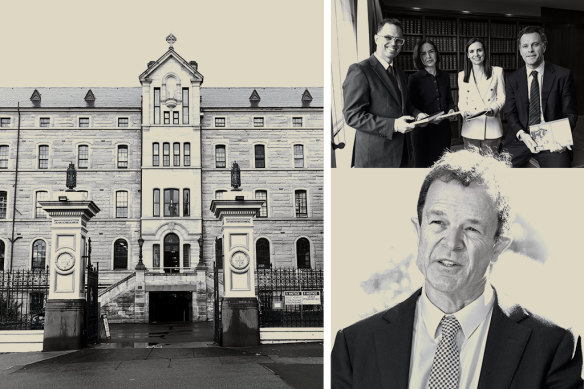- Exclusive
- National
- NSW
- State Parliament
Private, public or selective? Where the people ruling NSW went to school
Only one minister in the NSW government graduated from an academically selective school and most received a public education at their local comprehensive.
A Herald analysis of where ministers went to school shows that at least 77 per cent went to public school and four had a Catholic education.
Premier Chris Minns went to Marist College Kogarah and Deputy Premier Prue Car attended Caroline Chisholm College in Sydney’s west, both systemic Catholic schools which charge relatively low fees.
About 22 per cent of NSW ministers attended Catholic schools, a figure broadly in line with the current shared school age population enrolled in Catholic systemic schools.
Treasurer Daniel Mookhey is the only member who attended a selective school. He graduated from Girraween High School near Parramatta. His political leanings were evident back then.
“In high school, organising meant cornering my schoolmates after the federal budget, hectoring them about how the Liberal government was slashing pensions, starving universities and reneging on its promise to act on child care,” Mookhey said in his inaugural speech to parliament.
Health Minister Ryan Park went to Dapto High; Transport Minister Jo Haylen went to Willoughby Girls; and Finance Minister Courtney Houssos went to Forster High.
On the Coalition frontbench, nine ministers were publicly educated, three went to systemic Catholic schools and eight attended private schools, making up 36 per cent of shadow cabinet, roughly double the proportion of the 16 per cent of NSW students getting a private education today.
Liberal leader Mark Speakman went to Caringbah High in the Sutherland Shire. He later went on to study at Cambridge. Coalition education spokeswoman Sarah Mitchell went to Gunnedah High.
Some MPs went to the same school as their political rivals, at different times: Alistair Henskens went to Newcastle High, as did Labor Roads Minister John Graham. Mark Coure and Chris Minns both went to Marist College at Kogarah.

Most Labor frontbenchers went to public schools but the statistics were different among the Coalition.Credit: Marija Ercegovac
Numerous Nationals MPs went to boarding schools, including Justin Clancy, who went to St Joseph’s College Hunters Hill. Dugald Saunders spent the last four years of his schooling at St Andrew’s Cathedral School.
In the Liberal Party, Mark Taylor went to selective school James Ruse Agricultural High School. Kevin Anderson never went to school and received his high school education via correspondence.
University of Canberra political historian Dr John Hawkins said Coalition members tended to be more likely to have gone to private school.
“The tradition has been that they tend to come from wealthier families who can afford it,” he said.
“Labor tends to come from a poorer background, and be Catholic. However, that is breaking down in recent decades.”
While most of the Labor frontbench went to public schools, he said it was harder than in decades past for working-class people to land a career in politics. He said it appeared easier for working-class people to get a career in politics in decades gone past.
“There are now very few who don’t have a university degree,” he said.
An analysis last year found in the federal parliament, 69 per cent of Coalition members went to private school. Of Labor MPs, 49 per cent were privately educated.
Monash University head of politics Dr Zareh Ghazarian voters typically wanted to see themselves reflected in political candidates.
“It goes to the heart of the current debate about how representative MPs are of the broader community. It is a debate filtering through to voting choices in recent years, as we’ve seen the major parties lose ground,” he said.